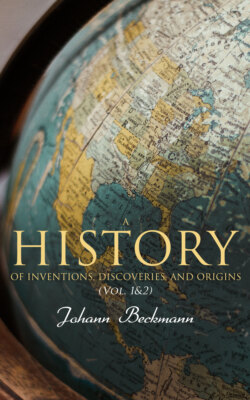Читать книгу A History of Inventions, Discoveries, and Origins (Vol. 1&2) - Johann Beckmann - Страница 14
На сайте Литреса книга снята с продажи.
FOOTNOTES
Оглавление28 [Among the improvements of recent date there are perhaps none of greater importance than those of electro-gilding and gilding by immersion, which have almost entirely superseded the process of gilding by an amalgam of mercury and gold, so fatal to the workmen exposed to the deleterious effects of the mercurial vapours. It is not our intention to enter at present into a history of the invention of these processes; they will more properly be reserved for a future volume, in which the discoveries of the present century will be treated of. The following short outline may however not prove uninteresting to the reader:—It had long been known to experimentalists on the chemical action of voltaic electricity, that solutions of several metallic salts were decomposed by its agency, and the metal produced in its free state. The precipitation of copper by the voltaic current was noticed by Mr. Nicholsona in a paper entitled ‘Account of the new Electrical Apparatus of Sig. Alex. Volta, and experiments performed with the same;’ but the earliest recorded process in electro-gilding is probably that contained in a letter from Brugnatelli to Van Monsb, in which he states that he had deposited a film of gold on ten silver medals by bringing them into communication by means of a steel wire with the negative pole of a voltaic pile, and keeping them one after the other immersed in ammoniuret of gold newly made and well-saturated. This announcement of a process identical with those now extensively used, attracted no attention at the time it was made, and no further experiments on the application of electricity to the deposition of metals for the purposes of the arts were published until the year 1830, when Mr. E. Davy read a paper before the Royal Society, in which he distinctly states that he had gilded, silvered, coppered and tinned various metals by the voltaic batteryc. The experiments of Brugnatelli and Davy were however completely lost sight of, and the art may be said to date its origin from the period when the late Professor Daniell described his constant battery. Since that time the art has continued to advance most rapidly, either in the perfecting of the apparatus or in the pointing out of more suitable salts of gold and silver, from which the metals might be precipitated. Among those who have contributed to its advancement we may particularly instance the names of our countrymen, Woolrich, Spencer, Jordan, Mason, Murray, Smee, Elkington, Fox Talbot, and Tuck. Nearly all the gilt articles manufactured at Birmingham are now gilded by the process patented by Mr. Elkington, in which, after the articles have been cleansed by a weak acid, they are placed in a hot solution of nitro-muriate of gold, to which a considerable excess of bicarbonate of potash has been added; in the course of a few seconds they thus receive a beautiful and permanent coating of gold.]
a Nicholson’s Journal, July 1800, p. 179.
b Philosophical Magazine, 1805.
c Phil. Trans. 1831, p. 147.
29 Lib. xxxiii. cap. 6.
30 Vit. lib. vii. c. 8.
31 In Origin. lib. xvi. c. 18.
32 De Aurilegio, præcipue in Rheno. Argent. 1776.
33 Historia naturale e morale delle Indie. Venetia, 1596.
34 The same account as that given by Acosta may be seen in Garcilasso de la Vega, Commentarios reales; Lisboa 1609, p. 225; in Rycaut’s English translation, London 1688, fol. i. p. 347; and in De Laet, Novus Orbis, Lugd. Bat. 1633, fol. p. 447.
35 Vol. i. p. 414.
36 Hakluyt’s Collection of Voyages. London, 1600, fol. vol. iii. p. 466.
37 See La France littéraire. Paris, 1769, 2 vols. 8vo, vol. ii. p. 410.
